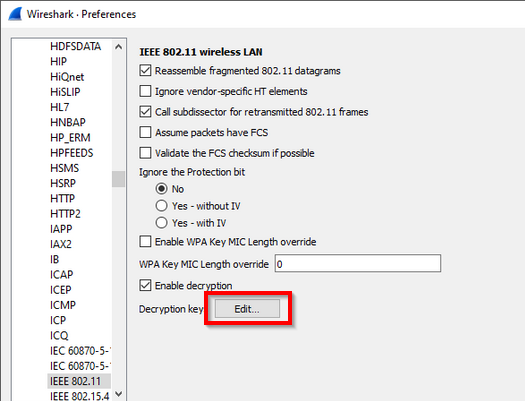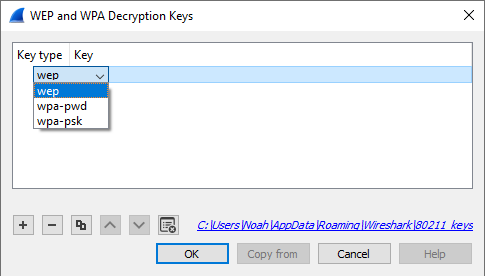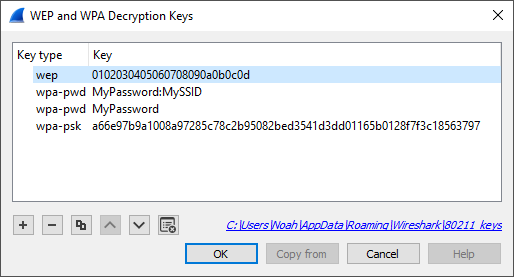Wireshark can decrypt WEP and WPA/WPA2/WPA3 in pre-shared (or personal) mode, as well as in enterprise mode. Security improvements in more recent 802.11 releases require distinct session keys, instead of being able to decipher all traffic to a given access point with a single known password and SSID.
You can add decryption keys using Wireshark’s IEEE 802.11 preferences. Up to 64 keys are supported.
Go to → → → , or, from the pop-up menu in the "Packet List" or "Packet Details" pane from a frame that contains IEEE 802.11, → . You should see a window that looks like this:
Click on the "Edit…" button next to "Decryption Keys" to add keys. You should see a window that looks like this:
When you click the + button to add a new key, there are five key types you can choose from: wep, wpa-pwd, wpa-psk, tk, or msk. The correct key type(s) depend on the Cipher Suite and Authentication and Key Management Suite (AKMS) used to encrypt the wireless traffic.
- wep
-
The key must be provided as a string of hexadecimal numbers, with or without colons, and will be parsed as a WEP key. WEP keys can be 40-bit (5 bytes, or 10 hexadecimal characters), 104-bit, or occasionally 128-bit:
a1:b2:c3:d4:e5
0102030405060708090a0b0c0d
- wpa-pwd
-
The password and SSID are used to create a raw pre-shared WPA key. The password can be between 8 and 63 characters, and the SSID can be up to 32 bytes. (Typically both are printable ASCII, but that is not a hard limitation of the specification, only a recommendation.)
MyPassword:MySSID
You can optionally omit the colon and SSID, and Wireshark will try to decrypt packets using the last-seen SSID. This may not work for captures taken in busy environments, since the last-seen SSID may not be correct.
MyPassword
| Note | |
|---|---|
|
The WPA passphrase and SSID let you encode non-printable or otherwise troublesome
characters using URI-style percent escapes, e.g., |
| Warning | |
|---|---|
|
The WPA pass-phrase and SSID method is for WPA/WPA2-Personal only. It will not work for WPA3-Personal, which uses SAE (Simultaneous Authentication of Equals), nor for the Enterprise / 802.1X / EAP modes. |
- wpa-psk
-
The key must be provided as a hexadecimal string, and is parsed as a PSK (Pre-Shared Key) or PMK (Pairwise Master Key). For WPA/WPA2-Personal, the PSK and the PMK are identical, and directly derived from the passphrase and SSID above. The keys can be 256 bits (32 bytes, 64 hex characters) or 384 bits (48 bytes, 96 hex characters).
0102030405060708091011...6061626364
- tk
- The key must be provided as a hexadecimal string, and is parsed as a PTK (Pairwise Transient Key) or GTK (Group Temporal Key). The keys can be 16 or 32 bytes (128 or 256 bits), depending on the cipher suite used. (5 and 13 byte WEP TKs are not yet supported.)
- msk
- The key must be provided as a hexadecimal string, and is parsed as a MSK (Master Session Key). This is used for FT-EAP (IEEE 802.11r Fast BSS Transition with EAP authentication). The key can be 64 or 128 bytes.
Along with decryption keys there are other preference settings that affect decryption.
- Make sure Enable decryption is selected.
- You may have to toggle Assume Packets Have FCS and Ignore the Protection bit depending on how your 802.11 driver delivers frames.
WPA and WPA2 use keys derived from an EAPOL handshake, which occurs when a machine joins a Wi-Fi network, to encrypt traffic. Unless all four handshake packets are present for the session you’re trying to decrypt, Wireshark won’t be able to decrypt the traffic. You can use the display filter eapol to locate EAPOL packets in your capture.
In order to capture the handshake for a machine, you will need to force the machine to (re-)join the network while the capture is in progress. One way to do this is to put the machine to sleep (for smartphones and tablets, "turning off" the machine puts it to sleep) before you start the capture, start the capture, and then wake the machine up. You will need to do this for all machines whose traffic you want to see.
If a TK is provided as a key, then the EAPOL 4-way handshake is not necessary, as the TK is what the handshake derives. However, all available TKs will be tried agi
WPA and WPA2 use individual keys for each device. Wireshark is able to handle up to 256 active associations, which should be enough in most circumstances. Nevertheless, if a capture has too many devices and too many associations, then while the packet list may show all packets decoded on the first pass, randomly accessing different packets in the packet details will result in some packets failing to be properly deciphered.
Filtering out only the relevant packets (e.g. with "wlan.addr") and saving into a new file should get decryption working in all cases, though it may require editing keys in the preferences or restarting Wireshark in order to free used associations. For the same reason, it is possible to be able to decode packets in a capture file without any EAPOL packets in it, as long as Wireshark did see the handshake for this communication in another capture without being restarted or editing keys. This can sometimes lead to exporting selected packets to a new file, opening that file and decoding seeming to work, but then decoding suddenly fail on the new file after Wireshark is restarted or keys are edited. If decoding suddenly stops working on a capture make sure the needed EAPOL packets are still in it.
As long as you can somehow extract the PMK from either the client or the Radius Server and configure the key (as PSK) all supported Wireshark versions will decode the traffic just fine up to the first EAPOL rekey.
EAPoL rekey is often enabled for WPA/WPA2 enterprise and will change the used encryption key similar to the procedure for the initial connect, but it can also be configured and used for pre-shared (personal) mode.
Decrypting IEEE 802.11r Fast BSS Transition roaming requires capturing reassociation frames for similar reasons, and is supported by recent Wireshark versions.
In WPA3, a different PMK is used for each connection in order to achieve forward
secrecy. Capturing the 4-way handshake and knowing the network password is not
enough to decrypt packets; you must obtain the PMK from either the client or
access point (typically by enabling logging in wpa_supplicant or hostapd
with the -d -K flags) and use this as the decryption key in Wireshark. Even
then, the decryption will only work for packets between that client and access
point, not for all devices on that network.
The TKs are the actual transient keys used to encrypt packets, which are derived during the handshake. If known, they can decrypt packets without having the handshake packets in a capture. However, having TKs as encryption keys in the table will affect IEEE 802.11 dissector performance as each encrypted packet will be tested against every TK until decryption is successful. If the table is configured with many TKs, none of which match any encrypted frame in the capture, performance can be slow.
Once a match is found, an association is formed similar to in the usual method and decryption of other frames with the same key should be on par with normal decryption flow. Thus, if most frames in the capture match TKs (or other keys), and only a limited number of TKs are configured, the performance impact is slight.


